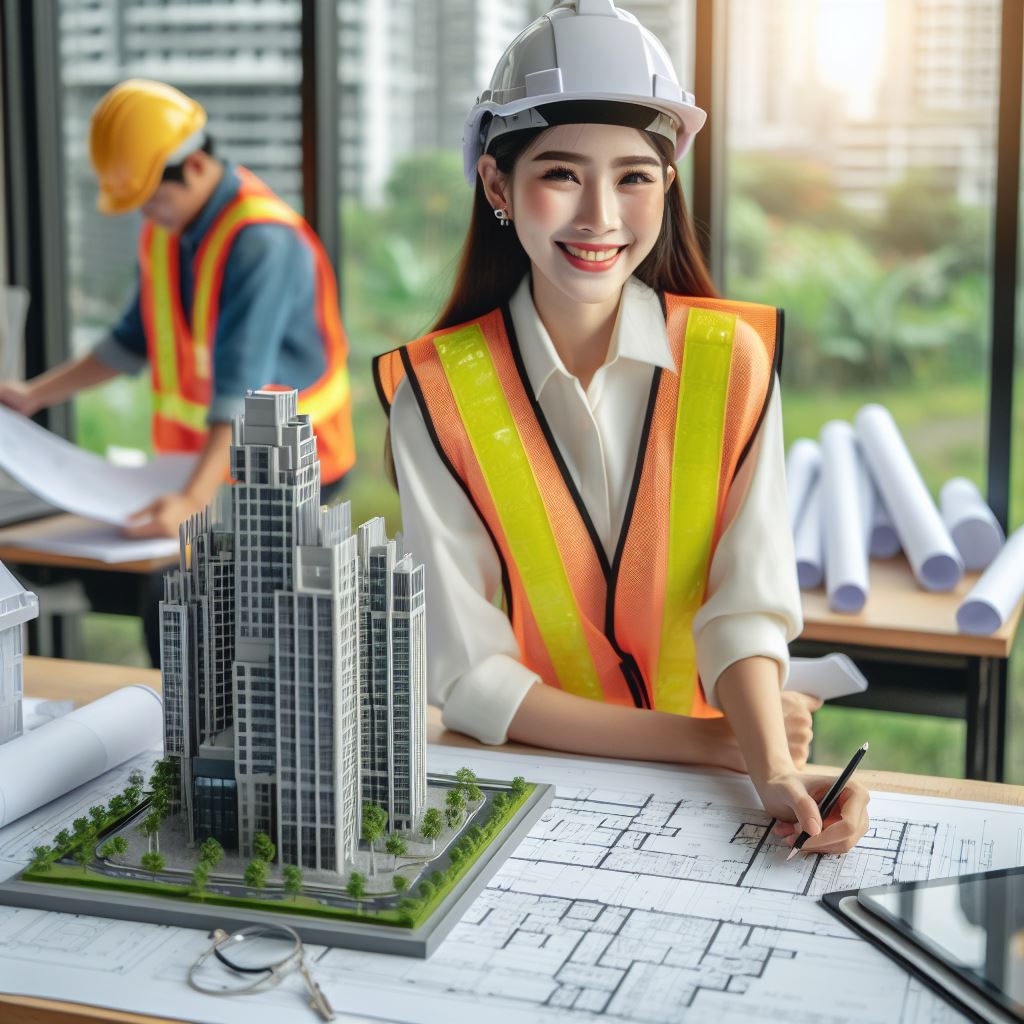Introduction
Green building is a significant trend in Canada’s architectural industry.
It focuses on creating environmentally friendly structures that minimize resource consumption and promote sustainability.
With growing awareness about climate change, the demand for green buildings is on the rise.
Can Canadian architects keep up?
Imagine walking into a building that not only astounds you with its architectural beauty but also leaves you marveling at its commitment to sustainability.
This is the future of green building in Canada – where design meets eco-consciousness.
The importance of green building cannot be overstated.
As one of the largest contributors to greenhouse gas emissions, buildings have a significant impact on the environment.
By adopting green practices, Canada aims to reduce its carbon footprint and create a more sustainable future.
But what exactly does green building entail? It involves using renewable materials, implementing energy-efficient systems, and utilizing innovative technologies.
These measures help decrease energy consumption, improve air quality, and conserve natural resources.
In Canada, the architectural industry is experiencing a shift towards green building practices.
With stricter regulations and government incentives, architects are increasingly incorporating sustainability into their designs.
The result? A wave of innovative and environmentally friendly buildings across the country.
From LEED-certified skyscrapers in Toronto to net-zero energy houses in Vancouver, green buildings are becoming the new norm.
Architects are embracing the challenge of incorporating eco-friendly features without compromising on aesthetics or functionality.
So, get ready to witness the transformation of Canada’s architectural landscape.
Green building is not just a passing trend; it is the future of sustainable construction in the country.
Join us on this journey as we explore Canada’s architectural shift towards a greener and more sustainable future.
Definition and Explanation of Green Building
Green building is an innovative approach to construction that focuses on sustainability and environmental responsibility.
It aims to minimize the negative impact on the environment throughout the entire building life cycle – from design and construction to operation and demolition.
Principles of Green Building
- Energy Efficiency: Green buildings prioritize energy conservation by reducing energy consumption and promoting the use of renewable energy sources such as solar or wind power.
- Water Conservation: They employ water-efficient fixtures and systems to reduce water consumption and minimize strain on local water supplies.
- Sustainable Materials: Green buildings utilize eco-friendly materials that are responsibly sourced, recycled, or renewable, minimizing waste and the depletion of natural resources.
- Indoor Air Quality: They prioritize the health and well-being of occupants by ensuring good ventilation, using low-emission materials, and minimizing exposure to pollutants.
- Waste Reduction: Green buildings aim to minimize construction and operational waste through effective recycling, salvaging, and waste management practices.
Benefits and Goals of Green Building
Environmental Benefits
- Reduced greenhouse gas emissions and carbon footprint.
- Protection and preservation of natural resources.
- Conservation of water and reduction of water pollution.
- Promotion of biodiversity and ecological balance.
Economic Benefits
- Lower energy and water bills for occupants.
- Increased property value and marketability.
- Job creation and economic growth in the green building sector.
- Long-term cost savings through reduced maintenance and operating expenses.
Health and Well-being Benefits
- Improved indoor air quality, leading to better occupant health and productivity.
- Enhanced thermal comfort and natural lighting, creating a pleasant living or working environment.
- Reduced exposure to harmful chemicals and toxins, promoting overall well-being.
Goals of Green Building in Canada
Net-Zero and Low-Carbon Buildings
- Aim to construct buildings that produce as much energy as they consume.
- Prioritize energy-efficient designs and the use of renewable energy sources.
- Reduce carbon emissions associated with building operation and occupant transportation.
Green Infrastructure and Resilience
- Incorporate natural features like green roofs, rain gardens, and permeable surfaces to manage stormwater and reduce urban heat island effect.
- Enhance building and community resilience to climate change impacts, such as extreme weather events and rising temperatures.
Sustainable Communities
- Promote walkability and active transportation.
- Encourage mixed-use development and compact communities to reduce urban sprawl and transportation emissions.
- Foster a sense of community and social interaction through the integration of public spaces and amenities.
In a nutshell, green building in Canada represents a significant shift towards sustainable construction practices.
By embracing the principles of energy efficiency, water conservation, sustainable materials, indoor air quality, and waste reduction, green buildings offer numerous benefits to the environment, economy, and human health.
The goals of green building in Canada revolve around achieving net-zero and low-carbon buildings, developing resilient communities, and fostering sustainable urban development.
Through these efforts, Canada is paving the way for a greener and more sustainable future.
Read: Electrical Engineering Innovations in Canada
Green Building Practices in Canada
The current state of green building in Canada
Green building practices have gained significant momentum in Canada, with the country becoming a leader in sustainable architectural projects.
As environmental consciousness continues to grow, so does the demand for eco-friendly buildings.
The current state of green building in Canada can be described as thriving.
The country has made significant progress in adopting sustainable construction practices, and numerous initiatives have been implemented to promote environmentally friendly designs.
One notable example is the Canada Green Building Council (CaGBC), a non-profit organization that facilitates the development and adoption of green building standards.
CaGBC has played a vital role in shaping the industry, pushing for greener building practices and encouraging innovation.
Furthermore, the government has recognized the importance of green building and has introduced measures to support its growth.
The LEED (Leadership in Energy and Environmental Design) certification program, for instance, provides incentives and recognition for buildings that meet sustainable criteria.
Some notable green buildings and sustainable architectural projects in the country
Canada boasts several outstanding green buildings and sustainable architectural projects that serve as inspiring examples for future constructions.
One notable project is the Manitoba Hydro Place in Winnipeg, which achieved LEED Platinum certification.
It combines energy-efficient design, renewable energy systems, and innovative approaches to water management.
Another remarkable example is the Dockside Green development in Victoria, British Columbia.
This mixed-use project incorporates sustainable building practices, including rainwater harvesting, on-site wastewater treatment, and passive solar design.
The Centre for Interactive Research on Sustainability (CIRS) in Vancouver is also worth mentioning.
It is a living laboratory showcasing sustainable technologies, such as solar shading devices, rainwater collection systems, and a green roof.
CIRS serves as a hub for research and education, further contributing to the advancement of green building practices in Canada.
These projects demonstrate Canada’s commitment to creating sustainable and energy-efficient buildings that minimize their environmental impact.
The reasons behind the increasing adoption of green building practices in Canada
Several factors contribute to the increasing adoption of green building practices in Canada.
First and foremost, the awareness of environmental issues has grown significantly among both professionals and the general public.
People are becoming more conscious of the impact construction has on climate change and are seeking more sustainable alternatives.
Additionally, the government’s commitment to environmental preservation has played a crucial role.
By implementing green building standards and offering incentives, the government has created a supportive environment for sustainable construction practices.
Moreover, the economic benefits associated with green buildings have attracted developers and investors.
These buildings offer reduced operational costs through energy and water efficiency, leading to long-term savings.
The market demand for green buildings has also increased, as occupiers and tenants are becoming more environmentally conscious and prefer sustainable spaces.
Lastly, advancements in technology and innovation have made green building practices more accessible and cost-effective.
The availability of sustainable materials, energy-efficient systems, and renewable energy sources has facilitated the adoption of green building practices.
In general, Canada has made significant strides in green building practices, with a thriving industry that showcases outstanding sustainable architectural projects.
The country’s commitment to environmental preservation, market demand, and technological advancements are driving the increasing adoption of green building practices.
As Canada continues to prioritize sustainability, the future of green building looks promising.
Read: How to Become an Electrical Engineer in Canada
Environmental and Economic Impact
Green building practices have emerged as a significant trend in Canada’s architecture industry, with a notable impact on both the environment and the economy.
The positive effects of green building on the environment are numerous and diverse.
By utilizing sustainable materials and construction techniques, green buildings minimize their carbon footprint and reduce harmful emissions.
This contributes to a cleaner, healthier environment for everyone.
Unlock Your Career Potential
Visualize a clear path to success with our tailored Career Consulting service. Personalized insights in just 1-3 days.
Get StartedOne major environmental benefit of green building is the reduction in energy consumption.
These buildings incorporate energy-efficient systems and design features that significantly decrease the need for electricity and fossil fuels.
By conserving energy, green buildings help mitigate climate change and decrease reliance on non-renewable resources.
Moreover, green buildings often employ renewable energy sources such as solar panels or wind turbines.
This alternative energy generation not only reduces greenhouse gas emissions but also promotes a shift towards a more sustainable and self-sufficient energy infrastructure.
Additionally, green building practices prioritize water conservation.
These buildings utilize technologies like rainwater harvesting and greywater recycling systems to reduce water wastage.
By doing so, they alleviate the strain on water sources and promote responsible water management in communities.
The positive impact of green building extends beyond the environment and also brings significant economic benefits.
Energy efficiency is a cornerstone feature of green buildings, leading to substantial cost savings for both occupants and owners.
These buildings consume less energy, resulting in reduced utility bills. Over time, the cumulative savings can be extensive and provide financial relief to individuals and organizations.
Furthermore, the adoption of green building practices stimulates job creation and economic growth.
As the demand for environmentally conscious construction increases, more workers are needed to implement these practices.
This opens up employment opportunities and boosts local economies.
Economic benefits of green building
In addition to short-term economic benefits, green building also offers long-term advantages for communities and their residents.
The use of sustainable materials, such as recycled or locally sourced resources, supports local industries and reduces reliance on imported materials.
This strengthens the local economy and fosters a sense of community pride.
Moreover, green buildings are designed with the well-being of occupants in mind.
They prioritize natural ventilation, daylighting, and the use of non-toxic materials, leading to improved indoor air quality and overall comfort.
This creates healthier living and working environments, promoting the well-being and productivity of residents.
Long-term benefits for the community and its residents
Green building practices also contribute to the overall resilience of communities.
By implementing sustainable design features, such as green roofs and permeable pavement, these buildings can better manage stormwater runoff, minimize urban heat island effect, and enhance overall community resilience to climate change impacts.
In summary, green building practices have a profound and positive impact on both the environment and the economy.
Through energy efficiency, water conservation, and the use of renewable resources, green buildings significantly reduce environmental harm.
Simultaneously, they generate cost savings, create jobs, and prioritize the well-being of residents, thus fostering sustainable and resilient communities.
Embracing green building in Canada is not only an architectural shift but also a step towards a more sustainable and prosperous future.
Read: Canadian Electrical Code: What Engineers Must Know

Government Initiatives and Regulations
The Canadian government plays a vital role in promoting green building practices in the country.
Through various initiatives, regulations, certifications, and incentive programs, they are driving the architectural shift towards sustainable construction.
Role of the Canadian Government
- The government actively encourages green building by setting environmental goals and targets for the construction industry.
- They provide financial support to promote the adoption of sustainable practices and technologies.
- The government also invests in research and development to advance green building technologies and materials.
- They collaborate with industry stakeholders and experts to develop regulations and standards for sustainable construction.
- The Canadian government promotes knowledge-sharing among architects, engineers, and builders to enhance green building practices across the country.
Specific Regulations, Certifications, and Incentive Programs
- The National Energy Code for Buildings sets requirements for energy efficiency in new constructions and major renovations.
- LEED (Leadership in Energy and Environmental Design) certification is widely recognized in Canada, encouraging builders to meet sustainable design and performance benchmarks.
- The government provides grants and tax incentives for green building projects, such as the ecoENERGY Innovation Initiative and the Green Municipal Fund.
- There are specific regulations for water management, waste reduction, and indoor air quality in green buildings.
- Various programs like the Canadian Green Building Council’s Zero Carbon Building Standard promote the construction of carbon-neutral buildings.
Importance of Government Support
Government support is crucial in driving the architectural shift towards green building practices:
- It creates a regulatory framework that ensures the implementation of sustainable measures in construction projects.
- Government initiatives provide financial incentives that make green building more economically viable for developers.
- Certifications and regulations establish a benchmark for quality and sustainability, giving credibility to green buildings in the market.
- Government-supported research and development lead to innovation in sustainable technologies, making them more accessible to the industry.
- By actively promoting green building, the government raises public awareness about the environmental benefits of sustainable construction.
In fact, the Canadian government’s role in promoting green building is pivotal.
Through regulations, certifications, and incentive programs, they create an enabling environment for sustainable construction practices.
Government support not only ensures compliance with environmental goals but also drives innovation and market acceptance for green buildings.
Read: Mech Engineers: Sustainability Focus
Uncover the Details: Aerial Surveying in Canada: Methods and Uses
Challenges and Solutions in Implementing Green Building Practices
Green building practices have been gaining momentum in Canada as architects, builders, and homeowners strive to create more sustainable and environmentally-friendly structures.
However, implementing these practices is not without its challenges.
In this blog section, we will explore the hurdles faced in adopting green building practices and potential solutions to overcome these obstacles.
Challenges
- Limited Awareness: One major challenge is the lack of awareness and understanding of green building practices among professionals and the general public.
- Resistance to Change: Many stakeholders are resistant to change and are hesitant to adopt new practices, especially if they involve additional costs or unfamiliar technologies.
- High Initial Costs: Green building materials and technologies often come with higher upfront costs, which can deter individuals from choosing sustainable options.
- Complexity and Lack of Standards: Implementing green building practices requires a deeper understanding of complex systems and standards. The absence of uniform guidelines can lead to confusion and implementation errors.
Potential Solutions
- Technological Advancements: Continued advancements in technology can help overcome challenges associated with green building. Architectural firms can leverage smart building systems and energy-efficient technologies to promote sustainability.
- Education and Training: Widespread education and training programs can help raise awareness about green building practices. Professionals should be equipped with the knowledge and skills necessary to implement sustainable designs.
- Collaboration and Information Sharing: Creating platforms for collaboration and information sharing within the construction industry can enhance the understanding and adoption of green building practices. This can be achieved through workshops, conferences, and online platforms.
- Incentives and Policies: Governments can play a significant role in promoting green building practices by offering financial incentives, tax breaks, and regulatory policies that encourage sustainable designs.
Cost Implications
- Life-cycle Cost Analysis: Although green building practices may have higher upfront costs, conducting a life-cycle cost analysis reveals the long-term economic benefits. Reduced energy consumption and maintenance costs can outweigh the initial investment.
- Cost-effective Materials and Technologies: The industry can work towards developing and promoting cost-effective green building materials and technologies. Investing in research and development can help drive down prices.
- Mass Production and Economy of Scale: As the demand for green building materials and technologies increases, mass production can lead to economies of scale, making them more affordable and accessible to a broader audience.
- Awareness of Return on Investment: Educating stakeholders about the return on investment associated with green building practices can help overcome the perception of high costs. Highlighting the long-term benefits, such as reduced energy bills and improved indoor air quality, can change perspectives.
In short, implementing green building practices in Canada faces several challenges, including limited awareness, resistance to change, high initial costs, and complexity.
However, with technological advancements, widespread education, collaboration, and supportive policies, these obstacles can be overcome.
Additionally, addressing cost implications through life-cycle cost analysis, cost-effective materials, mass production, and awareness of return on investment can lead to more affordable and accessible green building options.
Together, these solutions can fuel Canada’s architectural shift towards a more sustainable future.
Conclusion
The architectural shift towards green building in Canada is of great significance.
It not only addresses environmental concerns but also has numerous benefits for a sustainable and resilient future.
Green building practices contribute to energy efficiency, reduce carbon emissions, and promote healthier indoor environments.
They also create local job opportunities and spur economic growth.
By adopting green building practices in their personal and professional lives, readers can actively contribute to a cleaner and greener future.
This includes using sustainable materials, maximizing energy efficiency, and designing with nature in mind.
Supporting green building initiatives can be as simple as choosing green-certified products, investing in renewable energy, and advocating for stricter building codes and regulations.
Ultimately, embracing green building practices not only benefits the environment but also leads to cost savings, improved quality of life, and long-term resilience for communities across Canada.
So, let’s join forces and become champions of this architectural shift towards green building. Together, we can pave the way for a sustainable and resilient future!




